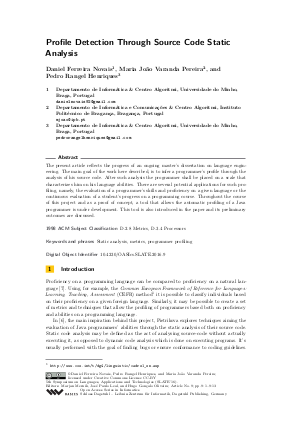Profile Detection Through Source Code Static Analysis
Authors Daniel Ferreira Novais, Maria João Varanda Pereira, Pedro Rangel Henriques
-
Part of:
Volume:
5th Symposium on Languages, Applications and Technologies (SLATE'16) (SLATE 2016)
Part of: Series: Open Access Series in Informatics (OASIcs)
Part of: Conference: Symposium on Languages, Applications and Technologies (SLATE) - License:
 Creative Commons Attribution 3.0 Unported license
Creative Commons Attribution 3.0 Unported license
- Publication Date: 2016-06-21
File

PDF
OASIcs.SLATE.2016.9.pdf
- Filesize: 496 kB
- 13 pages
Document Identifiers
Subject Classification
Keywords
- Static analysis
- metrics
- programmer profiling
Metrics
- Access Statistics
-
Total Accesses (updated on a weekly basis)
0PDF Downloads0Metadata Views
Abstract
The present article reflects the progress of an ongoing master's dissertation on language engineering. The main goal of the work here described, is to infer a programmer's profile through the analysis of his source code. After such analysis the programmer shall be placed on a scale that characterizes him on his language abilities. There are several potential applications for such profiling, namely, the evaluation of a programmer's skills and proficiency on a given language or the continuous evaluation of a student's progress on a programming course. Throughout the course of this project and as a proof of concept, a tool that allows the automatic profiling of a Java programmer is under development. This tool is also introduced in the paper and its preliminary outcomes are discussed.
Cite As Get BibTex
Daniel Ferreira Novais, Maria João Varanda Pereira, and Pedro Rangel Henriques. Profile Detection Through Source Code Static Analysis. In 5th Symposium on Languages, Applications and Technologies (SLATE'16). Open Access Series in Informatics (OASIcs), Volume 51, pp. 9:1-9:13, Schloss Dagstuhl – Leibniz-Zentrum für Informatik (2016)
https://doi.org/10.4230/OASIcs.SLATE.2016.9
BibTex
@InProceedings{ferreiranovais_et_al:OASIcs.SLATE.2016.9,
author = {Ferreira Novais, Daniel and Varanda Pereira, Maria Jo\~{a}o and Rangel Henriques, Pedro},
title = {{Profile Detection Through Source Code Static Analysis}},
booktitle = {5th Symposium on Languages, Applications and Technologies (SLATE'16)},
pages = {9:1--9:13},
series = {Open Access Series in Informatics (OASIcs)},
ISBN = {978-3-95977-006-4},
ISSN = {2190-6807},
year = {2016},
volume = {51},
editor = {Mernik, Marjan and Leal, Jos\'{e} Paulo and Gon\c{c}alo Oliveira, Hugo},
publisher = {Schloss Dagstuhl -- Leibniz-Zentrum f{\"u}r Informatik},
address = {Dagstuhl, Germany},
URL = {https://drops.dagstuhl.de/entities/document/10.4230/OASIcs.SLATE.2016.9},
URN = {urn:nbn:de:0030-drops-60142},
doi = {10.4230/OASIcs.SLATE.2016.9},
annote = {Keywords: Static analysis, metrics, programmer profiling}
}
Author Details
References
-
Thomas Flowers, Curtis Carver, James Jackson, et al. Empowering students and building confidence in novice programmers through gauntlet. In Frontiers in Education, 2004. FIE 2004. 34th Annual, pages T3H-10. IEEE, 2004.

-
Quinn Hanam, Lin Tan, Reid Holmes, and Patrick Lam. Finding patterns in static analysis alerts: improving actionable alert ranking. In Proceedings of the 11th Working Conference on Mining Software Repositories, pages 152-161. ACM, 2014.

-
Maria Hristova, Ananya Misra, Megan Rutter, and Rebecca Mercuri. Identifying and correcting java programming errors for introductory computer science students. ACM SIGCSE Bulletin, 35(1):153-156, 2003.

-
James Jackson, Michael Cobb, and Curtis Carver. Identifying top java errors for novice programmers. In Frontiers in Education, 2005. FIE'05. Proceedings 35th Annual Conference, pages T4C-T4C. IEEE, 2005.

-
Huzefa Kagdi, Michael L Collard, and Jonathan I Maletic. A survey and taxonomy of approaches for mining software repositories in the context of software evolution. Journal of Software Maintenance and Evolution: Research and Practice, 19(2):77-131, 2007.

-
Emília Pietriková and Sergej Chodarev. Profile-driven source code exploration. Computer Science and Information Systems (FedCSIS), pp. 929-934, IEEE., 2015.

- Raphael `kena' Poss. How good are you at programming? - a CEFR-like approach to measure programming proficiency, July 2014. URL: http://science.raphael.poss.name/programming-levels.html.
-
Alistair Sutcliffe. Human-computer interface design. Springer, 2013.

-
Nghi Truong, Paul Roe, and Peter Bancroft. Static analysis of students' java programs. In Proceedings of the Sixth Australasian Conference on Computing Education-Volume 30, pages 317-325. Australian Computer Society, Inc., 2004.

